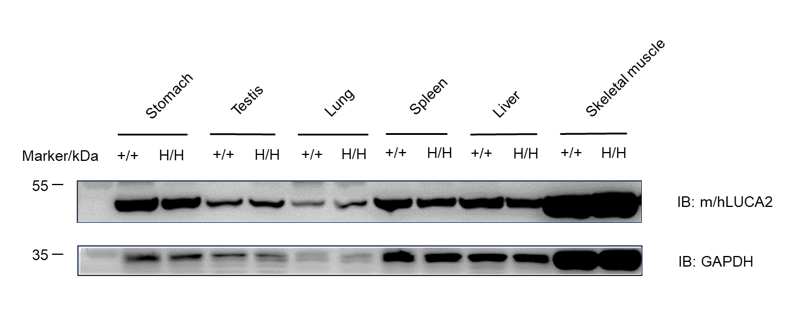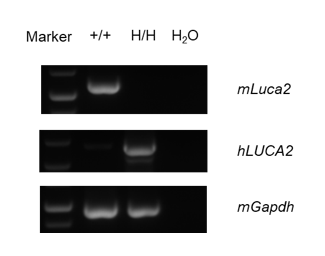B-hLUCA2 mice
| Strain Name |
C57BL/6N-Luca2tm1(LUCA2)Bcgen/Bcgen
|
Common Name | B-hLUCA2 mice |
| Background | C57BL/6N | Catalog number |
112499 |
|
Aliases |
HYAL2 | ||
Description
- HYAL2, a glycosylphosphatidylinositol (GPI)-anchored membrane receptor, binds and cleaves HMW-HA into low molecular-weight HA (LMW-HA; ~ 20 kDa) fragments at the cell membrane. This mechanism has been proposed to require the presence and activity of the major HA receptor CD44, which is essential for intracellular signaling. Inside lysosomes, HA is further processed into oligomeric HA fragments by HYAL1, together with exoglycosidases.
- Hyaluronidase (HYAL)-2 has been identified as one of the principal enzymes involved in HA catabolism in vertebrates. HYAL2 is broadly expressed in tissues but has catabolic function within only a narrow acidic pH range (optimal pH, 4), and compared to other HYALs, has only weak intrinsic HA-degrading activity.
- HYAL2 was originally identified as a lysosomal enzyme but was also subsequently identified as anchored to the cell membrane via a glycosylphosphatidylinositol link.15 Aberrant expression of HYAL2 is implicated in diverse pathology, including cardiac and skeletal abnormalities, hematopoietic and platelet dysfunction, cancer, and fibrosis.
Protein expression analysis

Western blot analysis of LUCA2 protein expression in homozygous B-hLUCA2 mice. Various tissue lysates were collected from C57BL/6N wildtype mice (+/+) and homozygous B-hLUCA2 mice (H/H), and then analyzed by western blot with anti-LUCA2 antibody. 40 μg total proteins were loaded for western blotting analysis. LUCA2 was detected in stomach, testis, lung, spleen, liver and skeletal muscle in wild-type C57BL/6N mice and homozygous B-hLUCA2 mice.
mRNA expression analysis

Strain specific analysis of LUCA2 mRNA expression in wild-type C57BL/6 mice and B-hLUCA2 mice by RT-PCR. Kidney RNA were isolated from wildtype C57BL/6 mice (+/+) and homozygous B-hLUCA2 mice (H/H), then cDNA libraries were synthesized by reverse transcription, followed by PCR with mouse or human LUCA2 primers. Mouse Luca2 mRNA was detectable only in wild-type C57BL/6 mice. Human LUCA2 mRNA was detectable only in homozygous B-hLUCA2 mice but not in wild-type mice.









